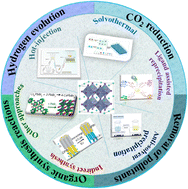Recent progress in metal halide perovskite-based photocatalysts: physicochemical properties, synthetic strategies, and solar-driven applications
Abstract
Metal halide perovskite (MHP) materials have garnered significant interest in the realm of energy conversion and storage amid the push for carbon-neutral energy solutions due to the tunable band gap, high light collection efficiency, high photogenerated carrier mobility, and high defect tolerance. Owing to the unique structure, MHPs have abundant active sites and can be easily functionalized, which is conducive to performance optimization for different applications. Herein, we reviewed the recent progress of MHPs systemically, covering physical and chemical properties, synthesis approaches, and their application in photocatalysis field. The photocatalytic applications of MHPs are mainly focused on hydrogen evolution, CO2 reduction, removal of organic pollutants, and organic synthesis reactions, such as photocatalytic C(sp3)–H bond activation, C–C, C–O, and C–N bond coupling. Various aspects related to activity performance assessments, mechanism discussions, and correlation comparisons are also displayed. Simultaneously, comprehensive design strategies, such as intrinsic engineering, surface engineering, and heterojunction engineering of high-activity, selectivity, and stability photocatalysts are required for solar-driven applications. Finally, the challenges and potential development opportunities associated with MHPs are outlined.

- This article is part of the themed collection: Journal of Materials Chemistry A Recent Review Articles


 Please wait while we load your content...
Please wait while we load your content...